I ran across this story while researching another one and thought you all might like to know- very interesting stuff. Read on.
Unless you’ve had cancer and chemo, you might not know that it’s an almost universal fact that people develop resistance to their chemotherapy. And it can be lethal for those with solid tumors (like breast, prostate, lung, and colon) that have metastasized. But a team of scientists led by the Hutchinson Center have discovered a key factor to this drug resistance and that might help doctors improve the effectiveness of traditional therapy.
Senior author, Dr. Peter Nelson, of the Hutchinson Center’s Human Biology Division explains that cancer cells live in a complex “neighborhood” and where they live and who they live near, influence their response and resistance to therapy.
The team found that when a normal, noncancerous cell living in the cancer’s neighborhood- the fibroblast- is exposed to chemotherapy, it sustains DNA damage which then drives the production of a broad spectrum of growth factors which in turn, stimulate cancer growth. So, to recap- when a fibroblast is exposed to chemo, it sustains DNA damage which makes the body turn on a growth factor which stimultes more cancer growth. Did you catch that?When circumstances in a neighborhood are ideal, fibroblasts help maintain the structural integrity of connective tissue and they play a critical role in wound healing and collagen production, but expose them to chemo, and the opposite happens.
From the article:
“Specifically, the researchers found that DNA-damaging cancer treatment coaxes fibroblasts to crank out a protein called WNT16B within the tumor neighborhood, or microenvironment, and that high levels of this protein enable cancer cells to grow, invade surrounding tissue and resist chemotherapy.
The researchers observed up to 30-fold increases in WNT production – a finding that was “completely unexpected,” Nelson said. The WNT family of genes and proteins plays an important role in normal development and also in the development of some cancers but, until now, was not known to play a significant role in treatment resistance.”
In the last decade, cancer therapies have become very specific; they now target key molecular engines that drive the cancer- as opposed to the older generic ones. But these new findings show that the tumor microenvironment can also influence the success or failure of these new and more precise therapies. The same cancer cell, depending on the neighboorhood, might have different responses to treatment.
Currenty, Nelson says that in the lab researchers are able to “cure” almost any cancer by simply giving very high and toxic doses of chemo to cells in a petri dish. However, if given to patients the chemo would not only kill the cancer, but also the patient.
More from the article:
“Therefore, treatments for common solid tumors are given in smaller doses and in cycles, or intervals, to allow the normal cells to recover. This approach may not eradicate all of the tumor cells, and those that survive can evolve to become resistant to subsequent rounds of anti-cancer therapy.”
While we are glad to know about any new research, we also believe there is an even better way. Near infrared sauna, cannabis oil, essential oils, vegan diets- there are a host of safer options out there. Make sure to educate yourself.
Source: Fred Hutch












